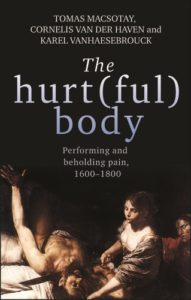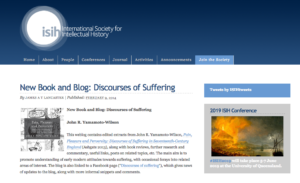The hurt(ful) body
Performing and beholding pain, 1600–1800
Edited by Dr Tomas Macsotay, Cornelis van der Haven and Karel Vanhaesebrouck
Manchester University Press, July 2017

I know! It has been too long – far too long – since I updated this blog! Nothing could illustrate that more clearly than the fact that this book came out a year ago and I am only now commenting on it, despite the fact that chapter 5, “Masochism and the female gaze”, was written by me!
This last year a lot of things have happened. Most notably, I retired from full-time teaching at Sophia University, Tokyo, in March. The whole build-up to, and immediate aftermath of, retirement was, for various reasons, quite a hectic time for me, and I just had to put some parts of my life on hold, including this blog.
But I’m back now, committed to posting regularly (once a week on average) and determined to catch up on lost ground.
So. The book. According to the blurb:
This book offers a cross-disciplinary approach to pain and suffering in the early modern period, based on research in the fields of literary studies, art history, theatre studies, cultural history and the study of emotions. The volume’s two-fold approach to the hurt body, defining ‘hurt’ from the perspectives of both victim and beholder – as well as their combined creation of a gaze – is unique. It establishes a double perspective about the riddle of ‘cruel’ viewing by tracking the shifting cultural meanings of victims’ bodies, and confronting them to the values of audiences, religious and popular institutional settings and practices of punishment. It encompasses both the victim’s presence as an image or performed event of pain and the conundrum of the look – the transmitted ‘pain’ experienced by the watching audience.
Or, if you prefer:
This book offers a cross-disciplinary approach to pain and suffering in the early modern period, based on research in the fields of literary studies, art history, theatre studies, cultural history and the study of emotions. It has a sustained focus on visual sources, textual material and documents about actual events rather than well-known thinkers or ‘masterpieces’ of art history, and a preference for cases and historical contexts over systematic theory-building. The hurt(ful) body brings under discussion visual and performative representations of embodied pain, using an insistently dialectical approach that takes into account the perspective of the hurt body itself, the power and afflictions of its beholder and, finally, the routinising and redeeming of hurt within institutional contexts. The volume’s two-fold approach of the hurt body, defining ‘hurt’ both from the perspective of the victim and the beholder (as well as their combined creation of a gaze), is unique. It establishes a double perspective about the riddle of ‘cruel’ viewing by tracking the shifting cultural meanings of victims’ bodies, and confronting them to the values of audiences, religious and popular institutional settings, and practices of punishment. It encompasses both the victim’s presence as an image or performed event of pain and the conundrum of the look – the transmitted ‘pain’ experienced by the watching audience. This will be done through three rubrics: the early modern performing body, beholder or audience responses, and the operations of institutional power. Because of its interdisciplinary approach of the history of pain and the hurt(ful) body, the book will be of interest for Lecturers and students from different fields, like the history of ideas, the history of the body, urban history, theatre studies, literary studies, art history, emotion studies and performance studies.
You can preview it on Google Books, and if you are interested in my chapter on masochism and the female gaze, here is a link to the final proof before publication. If you just want the gist, here’s the chapter abstract:
Masochism depends on fantasy, whether acted out or merely imagined, and the fantasy depends on an Other, who witnesses – either as an observer or as a participant – the suffering, real or imagined, of the fantasist, who in turn feels gratified. This particular concatenation of circumstances, though not recognized as a psychological predisposition until the nineteenth century, is generally considered to have emerged, in discourse and (probably) in practice, in the early modern period.[1] While there are potential dangers in reading the analyses of modern psychology back into earlier periods, there are also occasions when the insights of modern psychology can help to cast light on certain motifs and vignettes in early modern literature.
In this chapter, Yamamoto-Wilson examines the role of the Other’s gaze in early modern proto-masochistic fantasy, drawing on the poetry of (among others) William Browne, Aston Cokain, Michael Drayton, William Habington and Philip Sidney, the prose romance of John Crowne, the satire of Robert Greene and Thomas Nashe, a novella by Matteo Bandello, and the writings of Aphra Behn and Mary Wroth. By focusing on the function of the captivating female gaze, this chapter approaches the subversion of the chivalric tradition through the transgressive woman and the foolish man, and highlights the male anxiety generated by the female Other.
[1] Havelock Ellis, Studies in the Psychology of Sex, Vol. 3: Analysis of the Sexual Impulse; Love and Pain; The Sexual Impulse in Women (2nd edn, Philadelphia, 1920), p. 132, identifies Pico della Mirandola, Disputationes … Aduersus Astrologi. Diuinatricem [Arguments against astrological divination] (Bologna, 1496; repr. [Lyons, 1498?]), sig. h5r, as ‘the earliest distinct reference to a masochistic flagellant’ and Johann Heinrich Meibom, De flagrorum usu in re veneria [On the use of whips in sexual circumstances] (Leyden, 1639), as the first treatise on the subject. Roy F. Baumeister, Social Psychology and Human Sexuality: Essential Readings (Philadelphia, 2001), p. 308, says ‘The abundant evidence of masochistic activity beginning in the eighteenth century contrasts sharply with the lack of any record of such activities prior to the Renaissance’, and Gordon Williams, A Dictionary of Sexual Language and Imagery in Shakespearean and Stuart Literature, vol. 1 (London, 1994), pp. 513–6, notes the emergence from late Elizabethan times on of an early modern sexual identity which came, in the later part of the seventeenth century, to be known as a ‘flogging cully’ (a man who could only be sexually aroused by being whipped).
The book mainly focuses on the gaze in visual art. I think mine is the only chapter that doesn’t have any pictures! But the poems and other texts I examine conjure up plenty of images. For example:
Oh, cruel Nymph! why do’st thou thus delight
To torture me? why thus my suff’rings slight?
My mournfull Songs neglected are by thee,
Thou art regardless of my Verse, and me.
Thou canst behold, with an unpittying Eye,
My sorrows, and art pleas’d to see me dye.
(Jane Barker, ‘A Pastoral, in Imitation of Virgil’s Second Euclogue’. In Poetical Recreations , 1688, p. 211.



